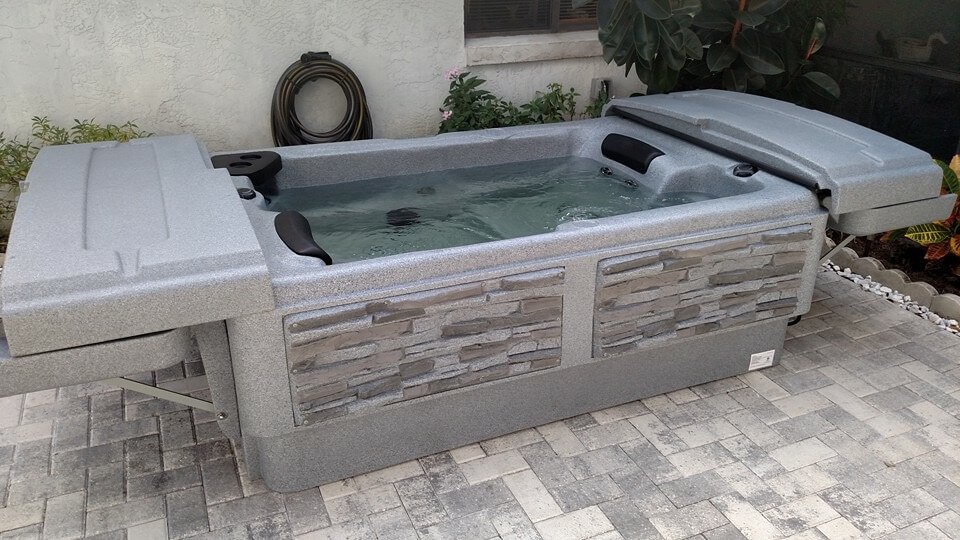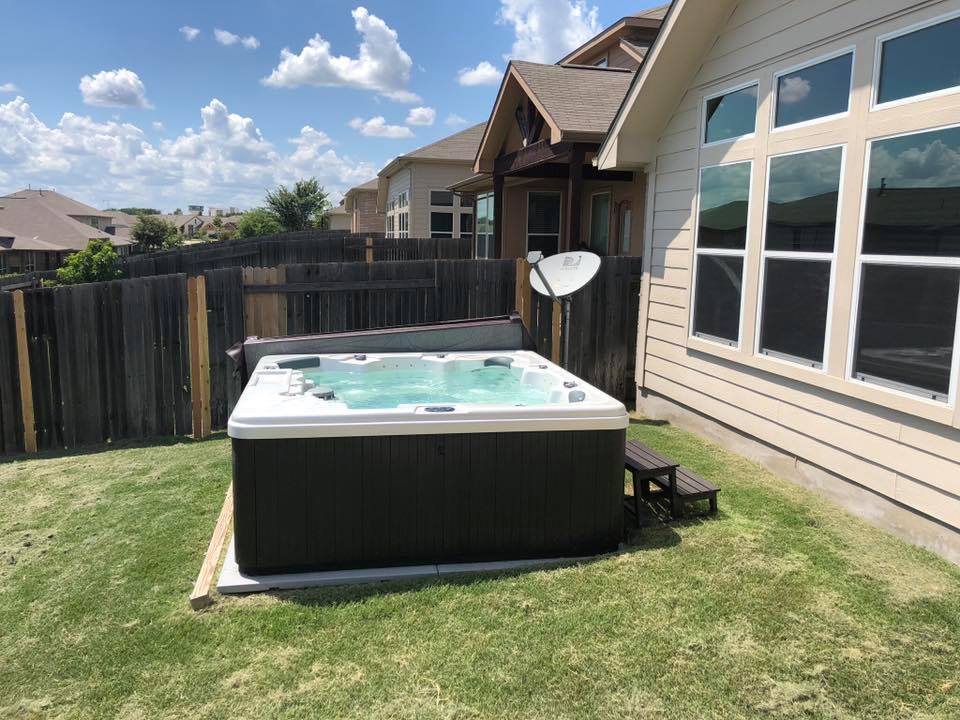Since ancient times, saunas have been a common feature of numerous cultures, from Russian banyas to Turkish baths and Native American sweat lodges. For the 5 million people that reside in Finland, where saunas are a common practice, there are 2 million saunas. But hot tubs have just as much historical popularity, from Roman bathhouses to the home spas many people enjoy today.
A hot tub in your backyard opens the door to many advantages that people have experienced throughout history. Your social life, physical health, and even emotional health can all be enhanced by a hot tub. What better way to improve your quality of life than with a new hot tub installation?
Similarity Between Saunas and Hot Tubs
In a traditional sauna, a room filled with wood is heated to a temperature that typically ranges from 160°F to 194°F. Pouring water on heated pebbles inside the sauna helps add humidity. If you’ve ever used a sauna, you know how humid the environment may become. You may even feel as though you are exercising without moving your body since your heart starts to race and your skin becomes greasy. Similar to exercise, research points to the long-term health advantages of routine sauna use.
Hot tubs, on the other hand, offer similar heat benefits with added enjoyment. After all, most people would rather relax in heated water with their friends than sit in a hot room. Hot tubs have the additional benefit of hydrotherapy jets to massage sore muscles, headrests for additional relaxation, and Bluetooth connectivity to allow you to play your favorite music.
Both hot tubs and saunas serve the same objective of heating the body to promote relaxation and health. Both can provide a sense of well-being, help reduce joint and muscular aches, and, more importantly, help you relieve stress after a tiring day!
Saunas and hot tubs are excellent locations to unwind, reduce stress, and spend quality time with the family. Either one can be used as a tranquil setting to meditate or chat with loved ones to discuss the day’s happenings.
Difference Between Saunas and Hot Tubs
A sauna is different from a hot tub in many ways:
In Terms of Aesthetics
In terms of aesthetics, hot tubs are more adaptable than saunas. A well-planned hot tub can be the deck or backyard’s architectural centerpiece. There are cabinet alternatives to suit each owner’s preferences and décor. Ambiance is created inside and outside the spa by dramatic LED lighting effects, waterfall features, and other amenities. Meditation and relaxation have long been linked to the calming sound of bubbling water. Many people also enjoy listening to music or watching TV while unwinding in the spa.
Saunas do not produce white noise, which can be a pro or a con depending on what helps you relax. Both indoor and outdoor saunas have the benefit of privacy, preventing anyone not in the sauna from seeing inside.
Deciding between saunas or hot tubs depends on your preferred environment for relaxation.
Massage Options
Catharsis after a long day is extremely beneficial, and hot tubs provide the added benefit of massage. Hot tub jets can be deliberately directed to tense areas on the body, depending on the hot tub model. Relaxing in a hot tub before bed allows for faster and deeper sleep by providing both physical relaxation of the muscles and mental relaxation. Your circulation can be improved, headaches and congestion can be relieved, and hot water and jet massages can help you feel less anxious and pained. Heat therapy in a hot tub can also improve the symptoms of ongoing health issues like rheumatoid arthritis.
Together Time
Hot tubs provide the ideal setting for a quiet escape or a romantic getaway in your backyard. Head to your hot tub to spend quality time interacting with the people that matter most to you. Your hot tub can be used for gatherings with friends and family, playing hot tub games in the water (especially if the model allows the temperature to be reduced to swimming levels), sharing laughs, and catching up on life.
For a romantic evening at home with your partner, gather a good book and some calming music, take a break from your daily obligations, and rest in the spa together. Hot tubs don’t get as hot as saunas so they can be suitable for a more extensive age range. Sauna temperatures may be uncomfortable or dangerous for kids or older people.
Installing a Hot Tub VS Sauna
Installing a hot tub is not as complicated as it may seem, but many customers will want to hire a professional. Plumbing is not required for a hot tub. The easiest hot tub to install is a 110V model, sometimes called a “plug and play” because you only have to connect it to a grounded household outlet. Much like you would for a dual fuel range or electric clothes dryer, you will need to contact a licensed electrician to modify the wiring if you get a 220V model hot tub.
Prefabricated saunas are available, and materials resistant to moisture and mold can be used to construct them. A sauna must be placed to allow heat and humidity to escape correctly so they don’t get trapped in the walls and foster mold formation. Depending on the size, plumbing, electricity, and other aspects of the building, the cost of the unit may increase significantly. Depending on what kind of sauna you have, you might have to install a detector for carbon monoxide or a chimney.
Maintenance
Both hot tubs and saunas require maintenance, but different types and to different degrees. The best hot tubs demand minimal maintenance costs when taken care of properly. Weekly water testing is typically needed in spas to ensure the proper chemical balance. Water pollutants are eliminated using hot tub filters. The filters should be washed once a month and changed occasionally. Some filters can be washed in the dishwasher, while others can be sprayed with a garden hose to clean them. Remember, when not used, a hot tub will require a cover to retain its heat.
After each use, experts advise brushing the inner surfaces of a sauna to keep it clean. Moreover, you must sand the interior entirely and frequently hose down the interior. To remove stains and mildew, scrubbing with a cleaning agent is necessary. Moving parts may need to be periodically sanded due to wood swelling. A spa generally requires weekly water tests to ensure the proper chemical balance. Outdoor saunas should occasionally have their exteriors pressure washed and stained.

Are Hot Tubs and Saunas Harmful?
Most people can benefit from using a hot tub. However, staying in a hot tub longer than recommended could lead to dehydration or fainting due to a drop in blood pressure. While a sauna can cause harm, this is generally due to excessive heat exposure, which should be managed by carefully controlling the temperature and time you stay in.
Hot tubs present a slip/fall risk, so take care when climbing into or out of a hot tub. Saunas can only have such high temperatures due to their low humidity, which is important to remember. If you tried to run a steam room at the same temperature, the moisture would be so hot that it would be too dangerous for humans to enter. While neither hot tubs nor saunas are inherently harmful, users should understand the risks so they can enjoy them safely.
Conclusion
Hot tubs and saunas both offer health benefits. Both require the owner’s attention to regular maintenance tasks for optimum results. Both hot tubs and spas decrease muscle tension, improve cardiovascular fitness, and help achieve deeper sleep.
Your choice depends on your goals. Are you looking for a fast way to warm up your muscles that meets your financial conditions? A sauna may be for you. Do you want a holistic way to relax and let your muscles recover? A hot tub may be the better choice.
At Aqua Living Stores, we provide the highest quality hot tubs spa accessories! We’re dedicated to helping you find a home spa with the features you care about, so you can experience deeper relaxation and better overall wellness.
Want to learn more? Call Aqua Living Stores today.









